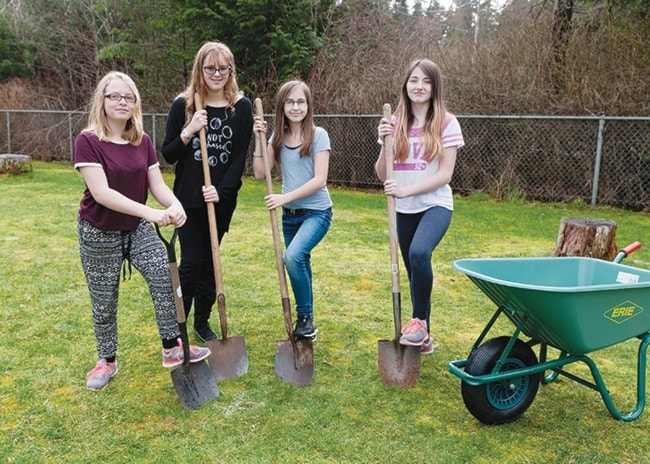On a grassy bench at the back of the Bowser Elementary School grounds, students have painstakingly mapped out and marked a network of trails, a fire pit and a traditional aboriginal building.
But it's not an archeological dig. It's a look at the near future.
With students playing a key, hands-on role, Bowser Elementary has begun phase I of the outdoor Tulnuxw lelum Cultural Learning Space, which will be used to augment instruction in First Nations culture and environmental studies.
"We have such a wonderful yard," said Laura Bonnor, a teacher who has taken on the project co-ordinator role. "We thought, why don't we put it to use as an educational space, as well?"
The idea of the outdoor cultural learning centre was first kicked around at the school during the 2014-15 school year, following several school closures and a reconfiguration by School District 69 boosted the student population in Bowser.
Nothing came of the discussions that year, but Bonnor brought it back up when school began last September, and plans and funding have begun to fall into place in the last few months, she said.
The facility will be built in two phases, the school announced. Phase 1 will include a garden made up of indigenous plants, paths, and a central seating area with a fire pit. It is expected to be completed this spring and an opening/welcoming ceremony has been scheduled for May 25.
Phase 2 will feature a covered and partially walled building reflective of First Nations culture and history, Bonnor said.
"Traditionally, it was always that way," said Carmen Forrest, First Nations Liaison for Bowser and Qualicum Beach elementary schools. "From elders teaching about edible and medicinal plants, to gathering and harvesting celebrations, it was aways done outdoors, that way."
The learning centre will be the first of its kind in the district, if not on Vancouver Island. School District 69 last fall signed its third Enhanced Aboriginal Education Agreement last fall, and a revised curriculum coming to British Columbia schools in the next year mandates all students be taught about First Nations history and culture "in an empowering and respectful manner," Bonnor said.
School officials believe the new outdoor centre at Bowser Elementary will enhance that instruction, with visits from elders and instruction in traditional plants with the plants right there on-site.
“It is wonderfully placed and timed, both in its relationship with the natural environment and with local First Nations,” Bowser principal Brian Nikula said. “And it’s perfectly suited for the new curriculum coming in.”
Even in the planning phase, students in teacher Dave MacVicar’s outdoor education program have already been learning lessons, from horticultural to use of hand- and garden tools, measuring and mapping and collaboration.
“They have important roles to play,” said Bonnor. “It’s empowering.”
When the digging comes, they will be involved in arranging and planting the native species.
Dorian Kisinger, a Grade 6 student and graphic artist, has teamed with a classmate to draw a pencil sketch of what the finished project will look like.
“I just asked if I could work on the blueprints for the building with a friend of mine,” said Kisinger. “The outdoor education class started designing it, so we did that. I’m hoping to help with the building. I love building.”
Bonnor has begun lining up funding for the project, including a $3,000 donation from the TD Bank Friends of the Environment Foundation and additional contributions from the Aboriginal Education Department and the province. Vancouver Island University teaching students Elisa Tulli and Lindsay Mitchell have held bake sales and other fundraisers, and have already contributed a wheelbarrow and gardening gloves.
“I just put some information on the project up on our (school) blog, and we’ve already got donations from two people after they saw it,” said Nikula.
“It’s getting a lot of support from the community.”
And Bonnor said she expects Tulnuxw lelum to get just as much use from that community.
“It’ll be an adventure for us, and the kids have been looking forward to it,” Bonnor said. “But it’s something the whole community can use. It won’t be locked up.”
